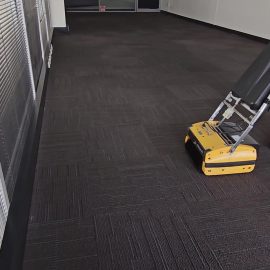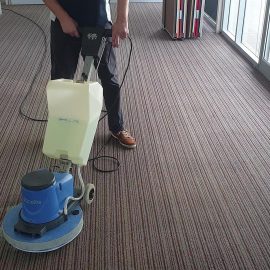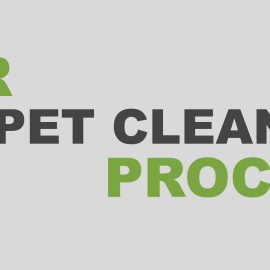
Before the advent of encapsulation technology, carpet cleaning was primarily done using the shampoo method. This involved applying a soapy solution to the carpet, scrubbing it in, and then vacuuming up the residue. While this method was effective in removing dirt, it often left behind a soapy residue that attracted more dirt over time, leading to rapid resoiling.
SHORT INTRODUCTION TO CARPET ENCAPSULATION
In the 1990s, the concept of encapsulation was introduced as a solution to the residue problem associated with traditional shampoo methods. The idea was to use polymers that would encapsulate or “trap” soil particles in the carpet upon drying, turning them into dry crystals that could be easily vacuumed away.
THE RISE IN POPULARITY
Encapsulation quickly gained traction in the 1990s due to its numerous benefits. Not only did it address the residue issue, but it also reduced drying times, used less water, and provided a longer-lasting clean compared to traditional methods. Additionally, because encapsulation uses less water, it reduces the risk of mold and mildew growth, which can be a concern with other carpet cleaning methods.
MODERN ADVANCEMENTS
With advancements in chemistry and technology, modern encapsulation products have become even more effective. Today’s encapsulants are designed to work with a variety of carpet types and soiling conditions. Moreover, they often include additional features like stain protectors, deodorizers, and brighteners to enhance the overall cleaning result.
As the world continues to shift towards eco-friendly and efficient solutions, the demand for encapsulation is expected to grow. Researchers are continually looking for ways to improve the encapsulation process, making it even more effective and environmentally friendly.
BREAKDOWN OF THE ENCAPSULATION CARPET CLEANING PROCESS
1.INITIAL VACUUMING
Purpose: The primary reason for vacuuming before applying the encapsulating solution is to remove the top layer of loose dirt, dust, and debris from the carpet. This step is crucial because if this loose dirt isn’t removed, it can interfere with the encapsulation process, reducing its effectiveness.
Depth of Cleaning: It’s not just about a quick run-over with a vacuum. This step requires a deep and thorough vacuuming, often using commercial-grade vacuums with strong suction power. These machines can lift and remove deeply embedded dirt particles that regular vacuums might miss.
Attention to Detail: Special attention should be given to high-traffic areas and edges where dirt tends to accumulate. Using crevice tools and edge cleaners can help ensure that even the tightest corners are free from debris.
2. CHOOSING THE RIGHT SOLUTION
The encapsulating solution is a specially formulated chemical that contains polymers designed to surround and isolate dirt particles. It’s essential to choose a high-quality solution that’s suitable for the specific type of carpet being cleaned. Factors like carpet material, level of soiling, and any specific stains or issues should be considered when selecting the solution.
3. APPLYING THE ENCAPSULATING SOLUTION
The method of application can vary based on the area’s size and the specific needs of the job:
Pump-Up Sprayers: These are handheld devices that allow for a controlled spray of the solution. They’re ideal for spot treatments, smaller rooms, or areas that require a more targeted application. The user can adjust the pressure and spray pattern to ensure an even application.
Rotary Machines: These machines utilize a disc or pad that oscillates or rotates at high speeds. The oscillating action creates a scrubbing effect, ensuring the encapsulating solution is evenly spread and that dirt is effectively dislodged. Rotary machines are particularly effective for carpets with a shorter pile or those that require a more aggressive cleaning approach.
Cylindrical Brushing Machines: These devices are equipped with rotating brushes that dive deep into the carpet’s pile. As the brushes rotate, they comb through the fibers, ensuring the encapsulating solution reaches even the most embedded dirt particles. Cylindrical brushing machines are ideal for carpets with longer piles or more intricate weave patterns, as they can navigate the depth and complexity of such carpets without causing damage.
Customization Based on Carpet Specifications: The choice between rotary and cylindrical machines isn’t arbitrary. Professionals assess the carpet’s pile length, density, material, and overall condition to determine the most suitable machine. This tailored approach ensures that the agitation process is both effective and gentle on the carpet.
4. AVOIDING OVER-SATURATION
One of the key aspects of the encapsulation process is ensuring the carpet doesn’t become too wet. Over-saturation can lead to longer drying times, potential mold growth, and can even dilute the encapsulating solution, reducing its effectiveness. It’s crucial to apply just enough solution to coat the fibers without soaking the carpet.
5. EVEN DISTRIBUTION
The goal during application is to achieve a uniform distribution of the solution across the carpet. This ensures that all areas, even those less visibly soiled, receive the benefits of the encapsulation process.
In essence, the preparation and application phase of carpet encapsulation is a delicate balance of thoroughness and technique. It sets the foundation for the subsequent steps in the cleaning process, ensuring maximum effectiveness and longevity of the results.
THE TECHNICALITIES OF DEEP AGITATION FOR OPTIMAL CLEANING RESULTS
1. MECHANICAL ACTION AND SOLUTION PENETRATION
Molecular Interaction: On a molecular level, when the encapsulating solution is applied to the carpet, it needs to come into contact with every dirt and soil particle. Agitation increases the chances of this interaction by spreading the solution more uniformly and ensuring it reaches the deeper layers of the carpet.
Surface Tension and Wetting Agents: The encapsulating solutions often contain surfactants, which are compounds that reduce the surface tension of a liquid. By reducing surface tension, the solution can spread more easily and penetrate deeper into the carpet fibers. Agitation aids in this process by mechanically dispersing the solution, allowing the surfactants to work more effectively.
Optimal Chemical Reaction: For the encapsulating polymers to work effectively, they need to be evenly distributed. Agitation ensures that these polymers are not just concentrated in one area but are spread out, allowing for a more consistent chemical reaction across the entire carpet surface.
2. BREAKING DOWN SOIL AND DIRT
Friction and Shear Forces: When tools like rotary brushes or cylindrical brushes agitate the carpet, they create friction and shear forces. These forces act on the dirt particles, breaking their adhesive bonds with the carpet fibers. On a microscopic level, the mechanical action of the brushes disrupts the electrostatic and van der Waals forces that hold the dirt particles to the fibers.
Particle Size Reduction: As the agitation continues, larger dirt and soil aggregates can be broken down into smaller particles. This is beneficial because smaller particles are easier for the encapsulating solution to surround and isolate. Moreover, smaller particles are more easily vacuumed up in the subsequent steps.
Enhanced Surface Area Exposure: By breaking down and dislodging the dirt, agitation increases the exposed surface area of the contaminants. This means that there’s more surface area for the encapsulating solution to act upon, leading to a more effective encapsulation process.
THE SCIENCE BEHIND CRYSTALLIZATION IN ENCAPSULATION
1. MOLECULAR TRANSFORMATION
Polymer Science: Polymers are large molecules made up of repeating subunits. In the encapsulating solution, these polymers are in a more fluid state, allowing them to flow and coat the carpet fibers and dirt particles. The polymers used in encapsulation are designed to undergo a phase transition from this fluid state to a solid state under specific conditions, such as evaporation of the solvent.
Evaporation and Phase Transition: As the solvent (usually water) in the encapsulating solution evaporates, the concentration of the polymers increases. This concentration shift, combined with the loss of the solvent, prompts the polymers to rearrange themselves. They transition from their random, coiled configurations in the liquid phase to a more ordered, aligned configuration in the solid phase, leading to the formation of crystal structures.
Nature of Crystals: These crystal structures are not the typical crystals one might imagine, like salt or sugar. Instead, they are microscopic, amorphous structures that are designed to be brittle and easily fractured by the action of vacuuming.
2. ISOLATION OF DIRT PARTICLES
Adhesion and Encapsulation: The polymers in the solution have adhesive properties, allowing them to stick to dirt particles. This adhesion is facilitated by various intermolecular forces, such as van der Waals forces and hydrogen bonding. As the solution dries and crystallization occurs, these adhered dirt particles are trapped within the growing crystal structures.
Physical Barrier: The encapsulated dirt particles are now surrounded by a physical barrier, which is the crystallized polymer. This barrier prevents the dirt particles from reattaching to the carpet fibers, effectively isolating them. The nature of this barrier is such that it’s easily broken by mechanical actions, like walking or vacuuming, making the removal of the encapsulated dirt straightforward.
Chemical Specificity: The encapsulating solutions are formulated with specific chemical properties to ensure that they target a wide range of dirt and soil types. This ensures that various contaminants, from organic matter to inorganic debris, can be effectively encapsulated.
THE CRUCIAL ROLE OF FINAL VACUUMING IN ACHIEVING A REVITALIZED CARPET APPEARANCE
1. UNDERSTANDING THE NECESSITY OF VACUUMING IN THE ENCAPSULATION PROCESS
Complementing the Encapsulation: The encapsulation method, with its advanced chemical solutions and processes, effectively isolates and traps dirt particles within crystalline structures. However, these encapsulated particles remain on the carpet’s surface until physically removed. This is where vacuuming comes into play. It’s not just an ancillary step; it’s the culmination of the encapsulation process, ensuring that all the encapsulated dirt and debris are effectively extracted from the carpet.
Enhancing Carpet Longevity: Regular and effective vacuuming post-encapsulation not only ensures cleanliness but also contributes to the carpet’s longevity. By consistently removing encapsulated dirt particles, the wear and tear on carpet fibers caused by embedded grit and debris are significantly reduced.
2. THE TRANSFORMATIVE RESULTS OF POST-ENCAPSULATION VACUUMING
A Visibly Revitalized Appearance: After vacuuming, the carpet undergoes a visible transformation. Gone are the dullness and the patches of dirt, replaced by a vibrant, even, and fresh appearance. The colors seem more vivid, and the overall texture is more inviting to the touch.
Tangible Softness and Texture: Beyond the visual appeal, the carpet feels noticeably softer underfoot. The removal of abrasive dirt particles restores the carpet’s natural plushness, making it more comfortable for daily use.
Protection Against Rapid Resoiling: One of the standout benefits of the encapsulation process is the protective barrier it forms against future dirt and stains. Post-vacuuming ensures that this protective layer remains uncompromised. As a result, the carpet not only stays clean immediately after the process but also resists dirt and stains for extended periods, reducing the need for frequent cleanings.
BENEFITS OF ENCAPSULATION IN OFFICE CARPET CLEANING
1. EFFICIENCY AND RAPID TURNAROUND
Time is Money: In the fast-paced world of office environments, time is a valuable asset. Encapsulation, with its swift process, ensures that carpets are cleaned and ready for use in record time.
Comparison with Traditional Methods: Traditional carpet cleaning methods, such as steam cleaning or shampooing, often leave carpets damp for extended periods. This prolonged drying time can hinder office operations, causing potential disruptions and loss of productivity. In contrast, encapsulation’s low-moisture approach ensures carpets dry rapidly, minimizing downtime and ensuring a smooth workflow.
2. DEEP CLEANING AND SUPERIOR STAIN REMOVAL
Beyond Surface Cleaning: Encapsulation isn’t just about addressing the visible dirt or stains. The method delves deep into the carpet fibers, ensuring a comprehensive clean.
Tackling Stubborn Stains: Whether it’s a coffee spill or ink blot, encapsulation’s powerful solution is designed to break down and encapsulate even the most tenacious of stains. The result is a carpet that’s not just superficially clean but deeply purified, radiating a fresh and revitalized appearance.
3. SUSTAINED CLEANLINESS AND COST SAVINGS
Protection Against Future Soiling: One of the unique attributes of encapsulation is the protective barrier it forms on the carpet. This barrier repels future stains and dirt, ensuring the carpet remains cleaner for extended periods.
Economic Benefits: With carpets staying cleaner for longer, there’s a reduced need for frequent cleaning sessions. This translates to tangible cost savings in the long run, both in terms of cleaning expenses and the extended lifespan of the carpet.
4. ECO-CONSCIOUS CLEANING FOR A GREENER TOMORROW
Reduced Water Consumption: Encapsulation stands out as a green cleaning method. Its low-moisture approach means significantly less water is used during the cleaning process compared to traditional methods. This not only conserves water but also reduces the energy costs associated with water heating.
Environmentally Friendly Solutions: The encapsulation process employs solutions that are often biodegradable. This commitment to eco-friendly chemicals ensures that the cleaning process has a minimal environmental footprint, aligning with the global shift towards sustainable and responsible practices.
CONCLUSION
Maintaining a pristine office environment is more than just about aesthetics; it’s about creating a healthy, productive space where employees can thrive. As we’ve explored in this article, encapsulation stands out as a revolutionary method in carpet cleaning, offering efficiency, eco-friendliness, and long-lasting results. But, like all specialized tasks, achieving the best results requires expertise.
If you’re looking for a professional carpet cleaner, consider the services of Commercial Carpet Cleaning Perth. With years of experience and a dedicated team trained in the latest encapsulation techniques, we guarantee your office carpets will not only look refreshed but also enjoy an extended lifespan. Entrust your carpet care to the experts and experience the unparalleled difference of a truly clean office environment. Contact us today to schedule a consultation and let us transform your workspace!



